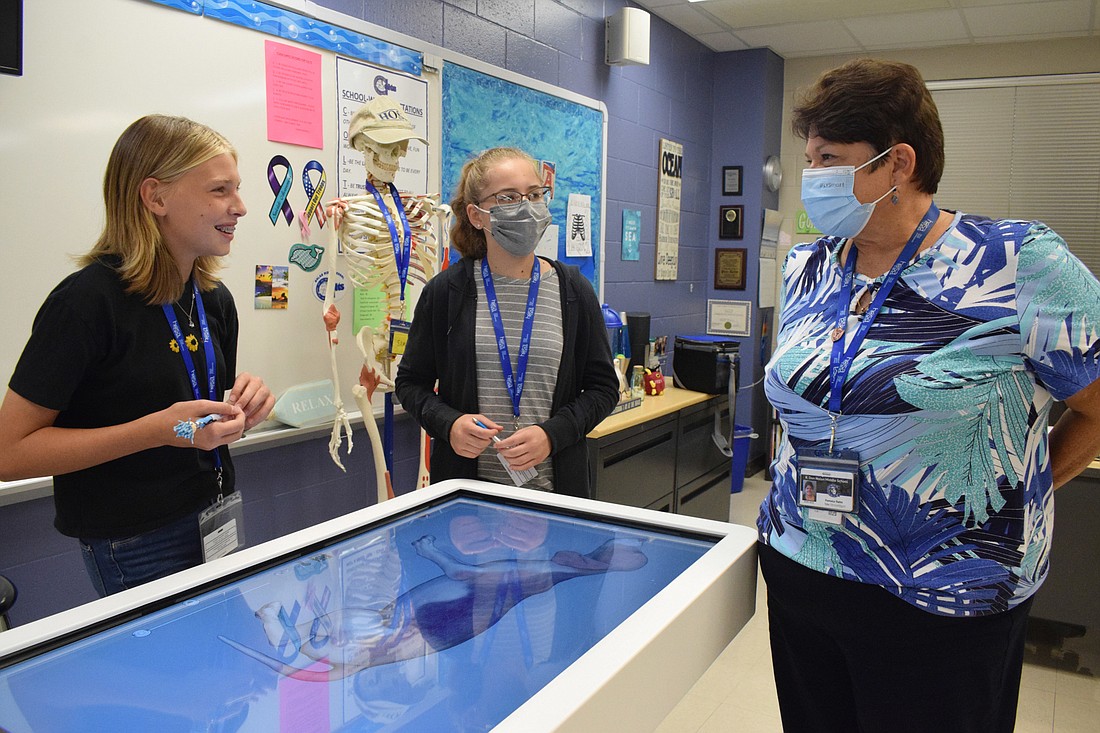- April 16, 2025
-
-
Loading

As a sixth grader at R. Dan Nolan Middle School, Payton Gee thought she might want to be a veterinarian.
That interest grew by leaps and bounds when she began to use the new Anatomage Table in seventh grade in the school's pre-medical program.
Anatomage Tables are essentially 8-foot touch-screen tables that provide 3D anatomy visualization and virtual dissection tools.
Included in Nolan Middle School’s Anatomage Table, which was purchased using funding from the School District of Manatee County’s 1-mill ad valorem property tax, are four virtual human cadavers and several animal bodies that were donated to science along with their case studies.
Gee’s ability to look at animals such as a dog, cat, snake, and turtle on the Anatomage Table, has solidified her desire to be a veterinarian as she moves on to high school next year.
“I enjoy looking at the different anatomy of the animals instead of just having a picture in a book,” Gee said. “It’s more interactive.”
The district’s 1-mill property tax referendum, which has collected more than $120 million since it was approved with 51% of the vote in 2018, has been used to begin new and enhance current STEM and career and technical education programs throughout the district.
The district spent $713,660 purchasing Anatomage Tables (one each) for Lakewood Ranch, Bayshore, Braden River, Manatee, Palmetto, Southeast and Parrish Community high schools as well as Nolan and Martha B. King middle schools.
While working with different features of the Anatomage Table Sept. 16, Gee and eighth grader Alexa Dziubek observed a human heart. They watched as the heart pumped in various speeds depending on the settings they established.
Within seconds, they were able to replace the heart with an image of a dog. They peeled back the dog's hair and skin to see the organs, muscles, skeleton and veins.
Pam Rahn, the pre-medical program instructor and Health Occupations Students of America co-advisor, said real cadavers can cost between $30,000 and $60,000 and come with a terrible smell as well as the need to disinfect the cadaver after each use.
The Anatomage Tables allow students the same experience as using a real cadaver but with less cleanup, and students are able to see more than one cadaver.
“I learn with the students,” Rahn said. “It’s fun to explore things together, and as the instructor, watching the students’ reactions is cool.”
Brittany Dunfee, a technology teacher at Braden River Middle School, has been able to structure her curriculum around the technology she received from the extra millage. She has six 3D printers, a Universal Robot and a laser engraver.
“I prepare kids for not only high school but also college or careers straight out of high school,” Dunfee said. “I give them a taste of everything, and I front load them with the basic skills. We’re preparing these kids for 21st century positions right out of high school.”
According to the Bureau of Labor Statistics, employment in computer and information technology occupations is projected to grow 13% from 2020 to 2030, adding about 667,600 new jobs in the U.S.
The different technologies provide real-world applications for students as well because a lot of the equipment, such as the 3D printers, laser engravers and robots, are machines used in manufacturing plants or by several companies. The Anatomage Tables give students case studies to analyze that help students understand more about the person they’re examining.
“Having the background story helps the kids understand what they’re looking at,” said Michelle Boculac, a HOSA co-advisor and pre-medical program teacher at Nolan Middle School. “The case study will explain the trauma that maybe a person went through or their medical history. As instructors, we can point those things out to students. It does kind of hit home that this was a real person that went through this trauma or had this accident or went through this disease.”
Dunfee and Boculac said their classes and programs give students an opportunity to see what career paths they might want to pursue after graduation.
“Some students have made up their minds and others are still in that ‘what do I want to do in life kind of thing,'” Boculac said. “For some of these kids, this is the road they want to take and being able to do this, it’s going to inspire them. It’s going to motivate them even more to follow their dreams and their pathways. Or they may choose another path because they realize this isn’t the one for them.”
Dunfee said it’s crucial for students to be exposed to different career paths early in their education rather than waiting until high school.
“I would say it’s even more valuable for middle school and elementary school teachers to have access to these tools to spark that motivation,” she said.
In Dunfee’s classes, students must learn the coding and programming involved in using machines like 3D printers and laser engravers before they’re actually able to use them. Learning how to use some of these programs, such as Adobe Illustrator, will help students in the future whether they want to go into a technology-related field or another field.
“The software is used in the high school level, college level and professional level,” Dunfee said. “That allows me to introduce all different types of careers.”
Dunfee said some students have taken what they’ve learned in class and went on to become entrepreneurs. For example, a student used the skills she learned about button making to create her own buttons that she sold at Comic Con.
“They’re no longer learning in theory,” Dunfee said. “They’re now allowed to learn in practice and learning by doing is one of the strongest ways to be able to connect to a subject matter. It’s one thing to teach kids engineering. It’s another thing to teach kids a Computer-Aided Design program where they can then design something three dimensional. It’s an entire other level of learning and application that sparks these kids.”